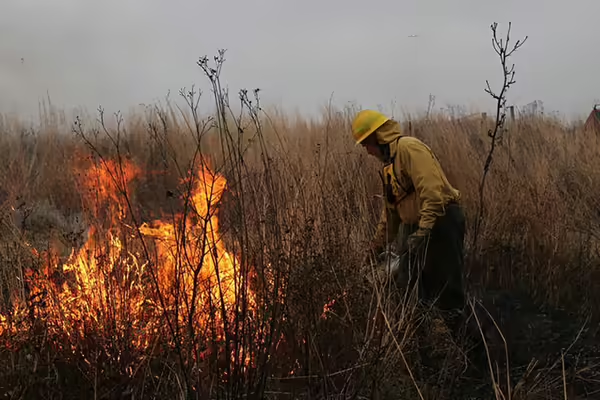
The U.S. National Science Foundation has announced new funding to understand and reduce grassland fire risk in the Southern Great Plains. The five-year project is being led by grassland fire expert Jon Henn at the University of Illinois Urbana-Champaign.
“While forest fires attract more attention, grassland fires are actually responsible for burning more homes because they burn faster and often occur in highly populated areas,” said Henn, assistant professor in the Department of Natural Resources and Environmental Sciences and Illinois Extension specialist; both units are part of the College of Agricultural, Consumer and Environmental Sciences at Illinois.
Grassland and shrubland fires have been responsible for devastating damage in Hawai’i, Colorado, Texas, Oklahoma, and California in recent years, but Henn says not enough research has been done to understand how fuel variability affects fire behavior. As part of the five-year NSF project, he will work with partners at Texas Tech University and the University of Colorado Boulder to measure grassland fuel characteristics throughout the Southern Great Plains, along with prescribed fire treatments, to predict how fuels drive fire risk.
Henn explains that grassland fuels — essentially, dry grass material — vary depending on habitat. For example, grasses grow bigger and faster in wetter climates like the Midwest, so there’s more material to burn when the grasses die. However, the amount of grassland on the landscape and the way that these ecosystems are managed — typically with grazing and controlled burns — varies across the Midwest and the Great Plains, and can have important effects on fire risk.
Read more from the College of Agricultural, Consumer, and Environmental Sciences.
University of Illinois Extension develops educational programs, extends knowledge, and builds partnerships to support people, communities, and their environments as part of the state's land-grant institution. Extension serves as the leading public outreach effort for University of Illinois Urbana-Champaign and the College of Agricultural, Consumer and Environmental Sciences in all 102 Illinois counties through a network of 27 multi-county units and over 700 staff statewide. Extension’s mission is responsive to eight strategic priorities — community, economy, environment, food and agriculture, health, partnerships, technology and discovery, and workforce excellence — that are served through six program areas — 4-H youth development, agriculture and agribusiness, community and economic development, family and consumer science, integrated health disparities, and natural resources, environment, and energy.